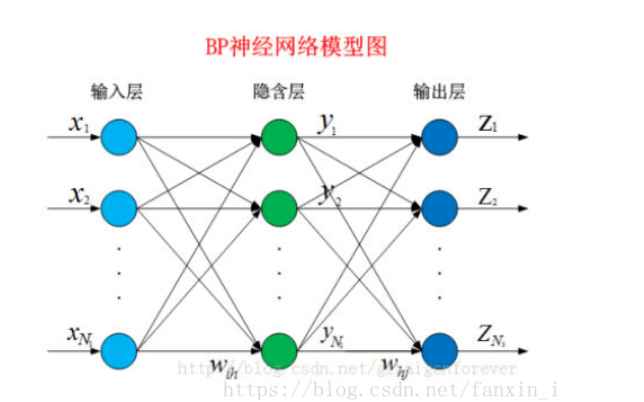BP神经网络及matlab实现
1、BP神经网络简介:其可以称为“万能的模型+误差修正函数”,每次根据训练得到的结果和预想结果进行误差分析,进而修改权值和阈值,一步一步得到能输出和预想结果一致的模型。
其是由输入层、隐藏层和输出层组成,对给懂的训练集进行训练,从而能够依据现有变量对需要的值进行预测。
具体过程可以见博客:https://blog.csdn.net/fanxin_i/article/details/80212906

Matlab实现的代码:
1 data=[6114 6425 6525 5732 6215 6645 2 138.69322 142.142486 134.925831 134.490744 126.613224 120.087785 3 83.540532 76.595546 72.291648 80.135362 79.936302 74.774776 4 0.924604 0.853992 0.814085 0.904912 0.901754 0.83836 5 ]; 6 inputdata=data(2:4,:); 7 outputdata=data(1,:); 8 [rows,cols]=size(inputdata); 9 % 取测试样本数量等于输入(训练集)样本数量,因为输入样本(训练集)容量较少 10 % 否则一般必须用新鲜数据进行测试 11 numberOfSample = cols; %输入样本数量 12 numberOfTestSample = cols; 13 numberOfForcastSample = 3; %预测步数 14 numberOfHiddenNeure = 10; %网络层数 15 inputDimension = rows; %输入变量数 16 outputDimension = 1;%输出变量数 17 %准备好训练集 18 output1=outputdata; 19 20 %由系统时钟种子产生随机数 21 rand('state', sum(100*clock)); 22 23 %输入数据矩阵 24 input = inputdata; 25 %目标(输出)数据矩阵 26 output = output1; 27 28 %对训练集中的输入数据矩阵和目标数据矩阵进行归一化处理 29 [sampleInput, minp, maxp, tmp, mint, maxt] = premnmx(input, output); 30 31 %噪声强度 32 noiseIntensity = 0.01; 33 %利用正态分布产生噪声 34 noise = noiseIntensity * randn(outputDimension, numberOfSample); 35 %给样本输出矩阵tmp添加噪声,防止网络过度拟合 36 sampleOutput = tmp + noise; 37 38 % 取测试样本输入(输出)与输入样本相同,因为输入样本(训练集)容量较少, 39 % 否则一般必须用新鲜数据进行测试 40 testSampleInput = sampleInput; 41 testSampleOutput = sampleOutput; 42 43 %最大训练次数 44 maxEpochs = 50000; 45 46 %网络的学习速率 47 learningRate = 0.035; 48 49 %训练网络所要达到的目标误差 50 error0 = 0.65*10^(-3); 51 52 %初始化输入层与隐含层之间的权值 53 W1 = 0.5 * rand(numberOfHiddenNeure, inputDimension) - 0.1; 54 %初始化输入层与隐含层之间的阈值 55 B1 = 0.5 * rand(numberOfHiddenNeure, 1) - 0.1; 56 %初始化输出层与隐含层之间的权值 57 W2 = 0.5 * rand(outputDimension, numberOfHiddenNeure) - 0.1; 58 %初始化输出层与隐含层之间的阈值 59 B2 = 0.5 * rand(outputDimension, 1) - 0.1; 60 61 %保存能量函数(误差平方和)的历史记录 62 errorHistory = []; 63 64 for i = 1:maxEpochs 65 %隐含层输出 66 hiddenOutput = logsig(W1 * sampleInput + repmat(B1, 1, numberOfSample)); 67 %输出层输出 68 networkOutput = W2 * hiddenOutput + repmat(B2, 1, numberOfSample); 69 %实际输出与网络输出之差 70 error = sampleOutput - networkOutput; 71 %计算能量函数(误差平方和) 72 E = sumsqr(error); 73 errorHistory = [errorHistory E]; 74 75 if E < error0 76 break; 77 end 78 79 %以下依据能量函数的负梯度下降原理对权值和阈值进行调整 80 delta2 = error; 81 delta1 = W2' * delta2.*hiddenOutput.*(1 - hiddenOutput); 82 dW2 = delta2 * hiddenOutput'; 83 dB2 = delta2 * ones(numberOfSample, 1); 84 85 dW1 = delta1 * sampleInput'; 86 dB1 = delta1 * ones(numberOfSample, 1); 87 W2 = W2 + learningRate * dW2; 88 B2 = B2 + learningRate * dB2; 89 W1 = W1 + learningRate * dW1; 90 B1 = B1 + learningRate * dB1; 91 end 92 %下面对已经训练好的网络进行(仿真)测试 93 %对测试样本进行处理 94 testHiddenOutput = logsig(W1 * testSampleInput + repmat(B1, 1, numberOfTestSample)); 95 testNetworkOutput = W2 * testHiddenOutput + repmat(B2, 1, numberOfTestSample); 96 %还原网络输出层的结果(反归一化) 97 a = postmnmx(testNetworkOutput, mint, maxt); 98 99 %绘制测试样本神经网络输出和实际样本输出的对比图(figure(bp1)) 100 t = 1:cols; %预测的图 101 %测试样本网络输出客运量 102 a1 = a(1,:); 103 %测试样本网络输出货运量 104 % a2 = a(2,:); 105 figure(1); 106 plot(t, a1, 'ro', t, output, 'b+'); 107 legend('网络销售量', '实际销售量'); 108 xlabel('周'); ylabel('销售量/件'); 109 title('神经网络销售量学习与测试对比图'); 110 grid on; 111 112 % 新的数据输入 113 newInput = [93.987 111.684 143.331; 62.846 71.317 77.109;0.705 0.792 0.839]; 114 %利用原始输入数据(训练集的输入数据)的归一化参数对新输入数据进行归一化 115 newInput = tramnmx(newInput, minp, maxp); 116 newHiddenOutput = logsig(W1 * newInput + repmat(B1, 1, numberOfForcastSample)); 117 newOutput = W2 * newHiddenOutput + repmat(B2, 1, numberOfForcastSample); 118 newOutput = postmnmx(newOutput, mint, maxt); 119 disp('预测10月份之后12周的销售量分别为(单位:件):'); 120 newOutput(1,:);%输出 or 不输出 121 122 [m,n]=size(newInput); 123 % 在figure(bp1)的基础上绘制预测情况bp2 124 figure(2); 125 t1 = 1:cols+n;%输入周横坐标 126 y=[7154,5756,7110]; 127 facoutputss=[a1,newOutput(1,:)]; 128 orioutput=[outputdata,y]; 129 plot(t1, facoutputss, 'ro', t1,orioutput, 'b+'); 130 % legend('网络输出销售量', '销售量'); 131 % xlabel('周'); ylabel('销售量/件'); 132 % title('神经网络销售量学习与测试对比图(添加了预测数据)'); 133 grid on; 134 135 % 绘制能量函数值的变化情况bp3 136 figure(3); 137 [m,n]= size(errorHistory); 138 t3 = 1:n; 139 plot(t3, errorHistory, 'r-'); 140 %为了更加清楚地观察出能量函数值的变化情况,这里我只绘制前100次的训练情况 141 xlim([1 100]); 142 xlabel('训练过程'); 143 ylabel('能量函数值'); 144 title('能量函数(误差平方和)在训练神经网络过程中的变化图'); 145 grid on; 146 147 result=newOutput(1,:);



